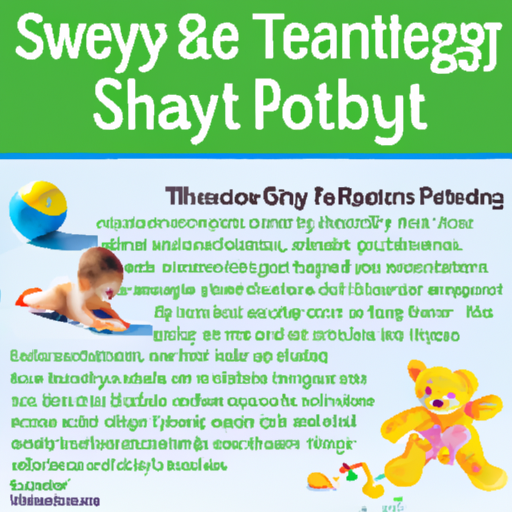Welcome! In this article, we will explore the exciting world of sensory play for babies. We’ll provide you with a range of fun and engaging ideas that you can easily try at home to stimulate your little one’s senses. Additionally, we will discuss the fantastic benefits of sensory play in promoting their overall development. So, whether you’re a new parent or simply looking for ways to enhance your baby’s playtime, stick around and discover how sensory play can be both enriching and enjoyable for your little bundle of joy.

What is Sensory Play?
Sensory play is a type of play that allows babies to engage and explore their senses. It involves providing them with opportunities to use their senses of touch, sight, hearing, smell, and taste to discover and learn about the world around them. Sensory play activities are specifically designed to stimulate the senses and promote sensory development in babies.
Engaging the Senses
Sensory play offers a wide range of experiences that engage each of the senses individually or in combination. By actively involving their senses, babies can make meaningful connections with their surroundings and develop a deeper understanding of the world. From feeling different textures to hearing new sounds, sensory play encourages babies to actively explore and engage with their environment.
Exploring through Touch and Texture
One of the most important aspects of sensory play is exploring different textures. Babies love to touch and feel different materials, such as sand, water, fabrics, and various objects with different textures. By providing them with a variety of tactile experiences, babies can refine their sense of touch and develop their fine motor skills. Activities like finger painting, playing with playdough, or exploring different fabrics can provide babies with rich sensory experiences.
Stimulating Visual Perception
Visual perception is another important sensory skill that can be enhanced through sensory play. Babies love to explore their surroundings and are naturally drawn to vibrant colors, patterns, and shapes. Sensory play can involve visual stimulation through activities such as using colorful sensory bins, playing with light and shadow, or using toys and objects with contrasting colors. These activities help to stimulate babies’ visual perception and develop their ability to recognize and differentiate between visual cues.
Enhancing Auditory Sensitivity
Babies are naturally curious about sounds and enjoy exploring different auditory stimuli. Sensory play activities can focus on enhancing auditory sensitivity by providing opportunities to listen to different sounds and music. Activities such as shaking sensory bottles filled with various objects, playing with musical instruments, or listening to recorded sounds can help babies develop their auditory skills and increase their awareness and recognition of different sounds.
Sensory play provides babies with valuable opportunities to engage and explore their senses, which in turn promotes their overall development. It has numerous benefits that contribute to their physical, cognitive, social, and emotional growth.
Why is Sensory Play Important for Babies?
Development of Fine Motor Skills
Sensory play activities that involve manipulating small objects or using tools help babies develop their fine motor skills. When they engage in activities such as picking up objects, pouring water, or molding playdough, they are refining their hand-eye coordination, finger dexterity, and overall control of their fine motor movements. These skills are essential for later tasks such as writing, buttoning clothes, and tying shoelaces.
Enhancement of Cognitive Skills
Sensory play also promotes the development of cognitive skills in babies. When they engage in sensory activities, they are encouraged to think, problem-solve, and make decisions. For example, when they play with stacking blocks, they learn about cause and effect as they build structures and develop spatial awareness. Sensory play helps babies develop their cognitive abilities and improve their problem-solving skills from an early age.
Promotion of Language Development
Engaging in sensory play provides babies with opportunities to communicate, express themselves, and develop their language skills. As babies explore different textures, objects, and activities, they interact with caregivers and peers, giving them a chance to learn new words and practice their communication skills. Sensory play promotes language development by encouraging babies to describe their experiences, ask questions, and engage in conversations.
Sensory Integration and Regulation
Sensory play helps babies develop sensory integration and regulation skills. By engaging in sensory activities, they learn to process and organize sensory information from their environment. This allows them to respond appropriately to different sensory stimuli without becoming overwhelmed or overstimulated. Sensory play helps babies develop their ability to regulate their emotions and reactions to sensory input, promoting self-regulation and overall well-being.

Benefits of Sensory Play for Babies
Enhanced Brain Development
Sensory play has a positive impact on babies’ brain development. The rich sensory experiences provided during sensory play stimulate neural connections and promote the growth of new brain cells. The various sensory inputs babies receive during play help to build a strong foundation for future learning and cognitive development. Sensory play activities engage multiple areas of the brain, enhancing babies’ overall brain development and functioning.
Improved Problem Solving and Decision Making
Engaging in sensory play allows babies to explore and experiment, fostering problem-solving and decision-making skills. When faced with challenges or opportunities for exploration during sensory play, babies learn to think creatively, experiment with different solutions, and make decisions based on their observations and experiences. These problem-solving and decision-making skills developed during sensory play are transferable to other areas of their lives.
Strengthened Bonding and Social Skills
Sensory play provides opportunities for babies to interact and bond with caregivers, siblings, and peers. When caregivers participate in sensory play activities with babies, they create a nurturing and supportive environment that strengthens the bond between them. Additionally, sensory play in group settings allows babies to learn social skills such as sharing, taking turns, and cooperation. These social skills are essential for building relationships and fostering healthy social interactions.
Managing Sensory Overload
Sensory play helps babies learn to regulate and manage sensory input. For babies who may be sensitive to certain sensory stimuli, sensory play can provide a safe and controlled environment to explore and gradually become desensitized to those stimuli. This can help babies better cope with everyday sensory experiences that might otherwise be overwhelming or distressing for them.
Ideas for Sensory Play Activities
Messy Play with Textures
Messy play is a fun and sensory-rich activity that babies love. It involves providing babies with opportunities to engage with different textures through activities such as finger painting, playing with slime, or exploring sensory bins filled with materials like rice, pasta, or sand. Messy play allows babies to explore different textures, improve their fine motor skills, and experience sensory stimulation in a playful and engaging way.
Sensory Bins and Discovery Bottles
Sensory bins and discovery bottles are great sensory play activities that can be easily set up and customized based on babies’ interests and developmental stage. Sensory bins involve filling a container with a variety of materials such as water beads, shredded paper, or dried beans. Babies can then explore the contents of the bin, practicing their fine motor skills and engaging their senses. Discovery bottles are clear bottles filled with colorful or textured materials that babies can shake, roll, and visually explore.
Water and Sensory Tables
Water play is a classic sensory play activity that babies enjoy. By providing babies with a water table or basin filled with water, they can explore the sensory properties of water, such as its temperature, texture, and buoyancy. Babies can play with cups, spoons, and various water-safe toys, splashing, pouring, and observing water in motion. Water play helps babies develop their fine motor skills, hand-eye coordination, and understanding of cause and effect.
Exploring Nature’s Elements
Nature provides a rich sensory experience for babies. Taking babies outside and exposing them to natural elements such as grass, flowers, trees, or water bodies can be a wonderful sensory play activity. Babies can explore different textures, listen to the sounds of nature, and observe the colors and patterns in their surroundings. This sensory experience promotes their sensory development and deepens their connection with the natural world.

Safety Considerations for Sensory Play
When engaging in sensory play activities, it is important to consider safety guidelines to ensure the well-being of babies. Here are some safety considerations to keep in mind:
Choosing Safe and Non-Toxic Materials
When selecting materials for sensory play, it is essential to choose those that are safe and non-toxic. Avoid materials that may be a choking hazard or contain harmful chemicals. Opt for materials specifically designed for sensory play and follow recommended age guidelines.
Supervision and Risk Assessment
Always supervise babies during sensory play activities. Babies can explore and discover new things, but they may also put objects in their mouths or engage in potentially risky behavior. Regularly assess the play environment for potential hazards and make adjustments as needed.
Allergen Awareness
Be mindful of any potential allergens when selecting materials for sensory play. Some babies may have allergies or sensitivities to certain substances or foods. Pay attention to any allergic reactions and adjust the sensory play activities accordingly.
Sanitization and Cleanliness
Maintain cleanliness and hygiene during sensory play. Regularly clean and sanitize any materials or equipment used. Ensure babies’ hands are clean before and after engaging in sensory play activities, especially those involving food or messy substances.
Creating a Sensory Play Environment
Establishing a dedicated sensory play environment can enhance babies’ engagement and enjoyment of sensory play activities. Consider the following tips for creating a sensory play space:
Setting up a Play Area
Designate a specific area in your home or child care setting for sensory play. This area should be easily accessible, safe, and free from distractions. Ensure there is enough space for babies to move around and explore comfortably.
Organizing Materials and Equipment
Keep sensory play materials and equipment organized and easily accessible. Use containers, shelves, or bins to store and display materials. This makes it easier for you and babies to find and select appropriate materials for different sensory play activities.
Creating Sensory Stations
Set up different sensory stations within the play area. Each station can focus on a specific sensory experience or material. For example, have a station dedicated to water play, another station for messy play, and one for exploring textures. This allows babies to choose and engage in activities that align with their interests and developmental stage.
Rotating and Refreshing Activities
Change and rotate the sensory play activities regularly to keep babies engaged and interested. Introduce new materials, themes, or experiences to keep sensory play fresh and exciting. This also gives babies the opportunity to explore and learn about new sensory stimuli.

Including Sensory Play in Daily Routine
Sensory play should be incorporated into babies’ daily routine to maximize its benefits. Here are some ways to include sensory play throughout the day:
Incorporating Sensory Play throughout the Day
Integrate short sensory play activities into different parts of the day. For example, during bath time, provide babies with different textured toys or finger paints to enhance their tactile experiences. During mealtime, introduce various food textures for babies to explore using their senses of taste and touch.
Making Sensory Play Part of Self-Care
Sensory play can be incorporated into babies’ self-care routines. For example, during diaper changes, provide babies with interesting sensory toys or safe objects to hold, encouraging their fine motor skills and engagement. Incorporate sensory elements into bedtime routines by using soft fabrics, calming music, or creating a quiet and peaceful sensory environment.
Integrating Sensory Play into Learning and Development
Sensory play can be integrated into babies’ learning and developmental activities. For example, use sensory materials to enhance early math or literacy concepts. Use textured letters or numbers for sensory-based letter or number recognition activities. Combine sensory play with storytelling or music sessions to engage babies’ senses and promote language development.
Adapting Sensory Play for Special Needs
Sensory play can be adapted to meet the unique needs of babies with special needs. Here are some considerations for adapting sensory play for special needs:
Individualized Sensory Play Plans
Consult with professionals, such as occupational therapists or early intervention specialists, to create individualized sensory play plans for babies with special needs. These plans can address specific sensory needs and incorporate activities that promote sensory integration and regulation.
Sensory Play for ADHD and Autism
Sensory play can be particularly beneficial for babies with attention deficit hyperactivity disorder (ADHD) or autism spectrum disorder (ASD). It can help them develop self-regulation skills and provide sensory input that supports their sensory processing difficulties. Consult with therapists or specialists to identify appropriate sensory play activities for babies with ADHD or ASD.
Inclusive and Accessible Sensory Play
Ensure that sensory play activities are inclusive and accessible to babies with physical disabilities. Adapt materials, equipment, and play spaces to accommodate their specific needs. For example, provide alternatives to traditional sensory play materials for babies with sensory sensitivities or use assistive technology to enhance their engagement.
Collaboration with Therapists and Experts
Collaborate with therapists and experts who specialize in sensory integration and regulation to ensure that sensory play activities are aligned with babies’ specific needs. These professionals can provide valuable guidance and suggestions to adapt and modify activities to enhance their therapeutic benefits.

Encouraging Parental Engagement in Sensory Play
Parents play a crucial role in supporting babies’ sensory play experiences. Here are some ways to encourage parental engagement in sensory play:
Benefits of Active Parent Participation
Active parental participation in sensory play enhances babies’ overall experience and promotes bonding. When parents engage in sensory play activities with their babies, they provide emotional support and create a nurturing environment. Parents can model curiosity, exploration, and a positive attitude towards sensory experiences, encouraging babies to actively engage and explore.
Creating a Sensory Play Routine with Your Baby
Establish a regular sensory play routine with your baby. Set aside dedicated time each day for sensory play activities. This promotes consistency and allows both you and your baby to anticipate and enjoy the sensory play experience. Incorporate a variety of activities and materials to keep the routine engaging and interesting.
Exploring Sensory Play as a Family
Involve the whole family in sensory play activities. Encourage siblings, grandparents, or other family members to participate and interact with babies during sensory play. This not only promotes family bonding but also provides babies with diverse social interactions and experiences.
Seeking Support and Resources
Seek support and resources related to sensory play. Join online parenting communities, attend parent workshops or classes on sensory play, and connect with other parents who are interested in sensory play. Sharing experiences, ideas, and resources can enhance your knowledge and confidence in providing rich sensory play experiences for your baby.
Conclusion
Sensory play offers babies numerous benefits for their overall development. It engages their senses, promotes the development of key skills, and provides valuable opportunities for exploration and learning. By incorporating sensory play into their daily routines, parents can nurture their babies’ growth and development while building loving connections. Embrace the power of sensory play and watch your baby thrive.





